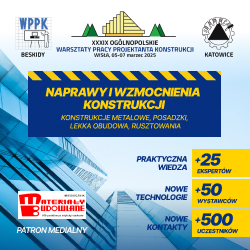Open Access (Artykuł w pliku PDF)
Ultracomposite lightweight aggregates – ecological and usefull management mineral and plastic waste
mgr inż. Piotr Górak, Politechnika Częstochowska; Wydział Inżynierii Mechanicznej i Informatyki
ORCID: 0000-0003-3479-7647
dr hab. inż. Przemysław Postawa, prof. PCz, Politechnika Częstochowska; Wydział Inżynierii Mechanicznej i Informatyki
ORCID: 0000-0001-7654-2963
Adres do korespondencji: Ten adres pocztowy jest chroniony przed spamowaniem. Aby go zobaczyć, konieczne jest włączenie w przeglądarce obsługi JavaScript.
DOI: 10.15199/33.2022.06.08
Oryginalny artykuł naukowy
Streszczenie. W artykule przedstawiono wyniki prac projektowych i badawczych, których celem było wytworzenie lekkiego kruszywa ultra kompozytowego (UCLA– ultracomposite lightweight aggregate) w wyniku połączenia odpadów pochodzących z różnych źródeł. Opracowana technologia wytwarzania pozwoliła na wykorzystanie odpadów pochodzących z termoplastycznych polimerów(PET) oraz mineralnych odpadów z procesów spalania, i pozyskanie kruszywa lekkiego mogącego znaleźć powszechne zastosowanie w budownictwie. W trakcie prac nad technologią wytwarzania nowego, ekologicznego kruszywa wykorzystano właściwości fizyczne termoplastycznych tworzyw sztucznych, w tym ich dużą lepkość w stanie stopionym. W wyniku odpowiednio przeprowadzonej obróbki termicznej w specjalnie zaprojektowanych warunkach wytworzono kompozyt w postaci granulek odpowiadających frakcji kruszywowej 2 – 8mm.Uzyskano różne rodzaje kruszyw lekkich wykonanych przy użyciu różnych drobnoziarnistych wypełniaczy mineralnych – ubocznych produktów spalania, których podstawowe właściwości zostały zbadane i zaprezentowane.
Słowa kluczowe: PET; lekkie kruszywo; uboczne produkty spalania; kompozyt; odpady; gospodarka obiegu zamkniętego.
Abstract. The paper presents the results of design and research work aimed at producing ultracomposite lightweight aggregate (UCLA) as a result of combining waste from different sources. The developed production technology allowed to utilize waste from thermoplastic polymers (PET) with mineral waste from combustion processes, and to produce a lightweight aggregate that can be widely used in construction. During the development of the technology to produce a new, ecological aggregate, the physical properties of thermoplastics and their high viscosity in the molten state were used. As a result of a properly conducted thermal treatment in specially designed conditions, a composite in the form of granules corresponding to an aggregate fraction of 2 – 8 mm was produced. Different types of lightweight aggregates made with various fine-grained mineral fillers – by-products of combustion – were obtained, the basic properties of which were studied and presented.
Keywords: PET; lightweight aggregates; coal combustion products; composite; wastes; circular economy.
Literatura
[1] https://plasticseurope. org/pl/wp-content/ uploads/sites/7/2021/12/AF-Plastics- -the-facts-2021_250122.pdf.
[2] Bimestre BH, Saron C. Chain extension of poly (ethylene terephthalate) by reactive extrusion with secondary stabilizer. Mat. Res. 2012; 15 (3): 467 – 472.
[3] Lopez M. del MC., Pernas AIA, Lopez MJA, LatorreAL, Vilari~no JML, Rodrígueza VG.Assessing changes on poly (ethylene terephthalate) properties after recycling: mechanical recycling in laboratory versus postconsumerrecycled material. Mater. Chem. Phys. 2-14; 147 (3): 884 – 894.
[4]DeBritoJ,EvangelistaL,Silvestre JD.Chapter11– Equivalent functionalunit inrecycledaggregate concrete. Pages 293-327. https://doi. org/10.1016/B978-0-08-102480-5.00011-7.
[5] Al-Tulaian BS,Al-ShannagMJ,Al-Hozaimy AR. Recycled plastic waste fibers for reinforcing Portland cement mortar. Construction and Building Materials. 2016; 127: 102–10. https://doi. org/10.1016/j.conbuildmat. 2016.09.131.
[6] KimJHJ, Park CG, Lee SW,Won JP. Effects of the geometry of recycled PET fiber reinforcement on shrinkage cracking of cement-based composites. Composites: 2008; Part B 39: 442–50. https://doi.org/10.1016/j.compositesb. 2007.05.001
[7] Al-Tulaian BS,Al-ShannagMJ,Al-Hozaimy AR. Recycled plastic waste fibers for reinforcing Portland cement mortar, Construction and Building Materials. 2016; 127: 102 – 110.
[8] Silva DA, Betioli AM, Gleize PJP, Roman HR, Gomez LA, Ribeiro JLD. Degradation of recycled PET fibers in Portland cement-based materials. Cement and Concrete Research. 2005; 35: 1741 – 1746.
[9] Kim J-H, Park C-G, Lee S-W, Won JP. Effects of the geometry of recycled PET fiber reinforcement on shrinkage cracking of cement- -based composites, Composites: 2008; Part B 39: 442 – 450.
[10] Wiliński D, Łukowski P, Rokicki G.Application of fibres from recycled PET bottles for concrete reinforcement. J. Build. Chem. 2016; 1: 1 – 9.
[11] Pereira de Oliveira LA, Castro-Gomes JP. Physical and mechanical behaviour of recycled PET fibre reinforced mortar. Construction and Building Materials. 2011; 25: 1712 – 1717. https://doi.org/10.1016/j.conbuildmat. 2010.11.044.
[12] Han C-G, Hwang Y-S, Yang S-H, Gowripalan N. Performance of spalling resistance of high performance concrete with polypropylene fiber contents and lateral confinement. Cement and Concrete Research. 2005; 35: 1747 – 1753.
[13] Karahan O, Atis CD. The durability properties of polypropylene fiber reinforced fly ash concrete. Mater. Des. 2011; 32: 1044 – 1049.
[14] Rebeiz KS, Fowler DW, Paul DR. Formulating and evaluating unsaturated polyester composite made with recycled PET. Journal ofMaterial Education. 1991; 13: 441 – 454.
[15] Rebeiz KS. Time-temperature properties of polymer concrete using recycled PET. Cement and Concrete Composites. 1995; 17: 119 – 124.
[16] Pelisser F, Montedo ORK, Gleize PJP, Roman HR. Mechanical properties of recycled PET fibers in concrete.Mater. Res. 2012; 15: 679 – 686.
[17] Foti D. Preliminary analysis of concrete reinforced with waste bottles PET fibers. Construction and Building Materials. 2011; 25: 1906 – 1915. https://doi.org/10.1016/j.conbuildmat. 2010.11.066.
[18] https://stat. gov. pl/obszary-tematyczne/roczniki- statystyczne/roczniki-statystyczne/rocznik- -statystyczny-przemyslu-2021,5,15. html
[19] Krajowy Plan Gospodarki Odpadami 2014 (M.P. nr 101, poz. 1183).
[20] PN-EN 450-1:2012. Popiół lotny do betonu – Część 1: Definicje, specyfikacje i kryteria zgodności.
[21] PN-EN 197-1:2012. Cement – Część 1: Skład, wymagania i kryteria zgodności dotyczące cementów powszechnego użytku.
[22] Yadong Li, et al. Composite material from fly ash and post-consumer PET. Resources, Conservation and Recycling. 1998; 24: 87 – 93.
[23] Sushovan Dutta et al. An Overview on the Use ofWaste Plastic Bottles and FlyAsh in Civil EngineeringApplications. Procedia Environmental Sciences. 2016; 35: 681 – 691.
[24] PN-EN 206+A1:2016-12. Beton – Wymagania, właściwości, produkcja i zgodność.
[25] PN-EN 13055:2016-07. Kruszywa lekkie. Część 1: Kruszywa lekkie do betonu, zaprawy i rzadkiej zaprawy.
[26] PN-EN12620+A1:2010.Kruszywa do betonu.
[27] PN-EN1097-6:2013-11. Badaniamechanicznych i fizycznych właściwości kruszyw. Część 6: Oznaczanie gęstości ziarn i nasiąkliwości.
[28] PN-EN 933-3:2012. Badania geometrycznych właściwości kruszyw. Część 3: Oznaczanie kształtu ziarn za pomocą wskaźnika płaskości.
[29] PN-EN ISO 11885:2009. Jakość wody – Oznaczanie wybranych pierwiastków metodą optycznej spektrometrii emisyjnej z plazmą wzbudzoną indukcyjnie (ICP-OES).
[30] PN-EN 12457-4:2006. Charakteryzowanie odpadów – Wymywanie.
Przyjęto do druku: 07.06.2022 r.
Materiały Budowlane 06/2022, strona 56-59 (spis treści >>)





























